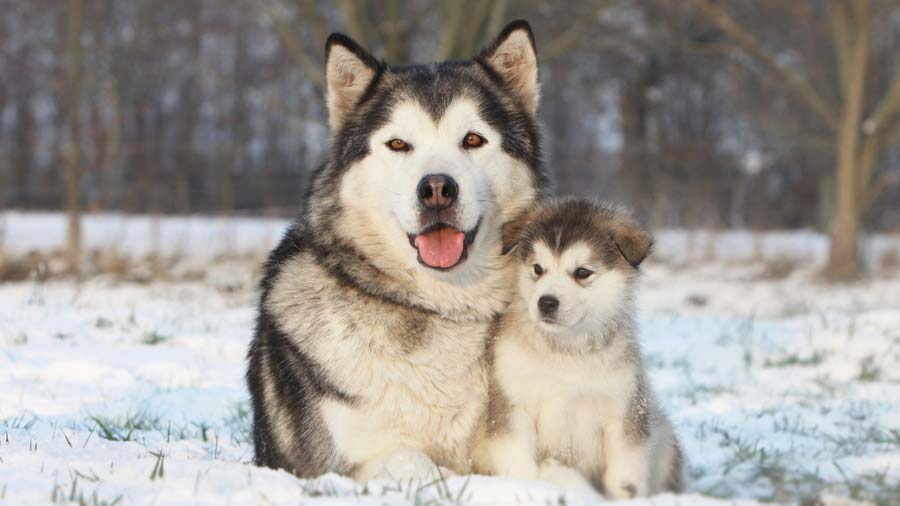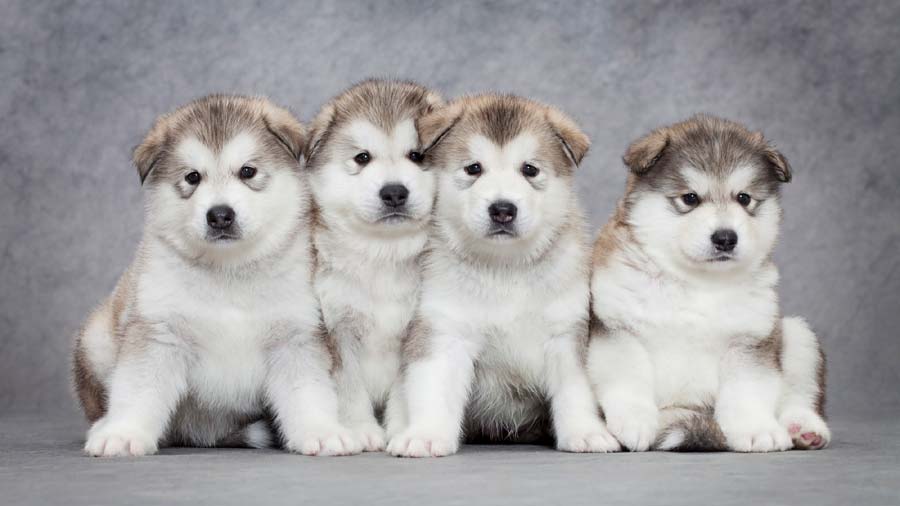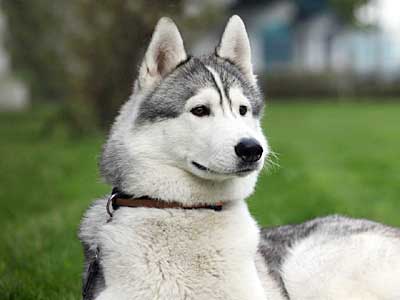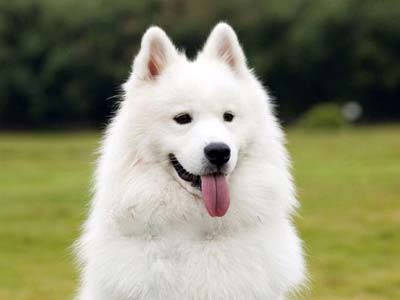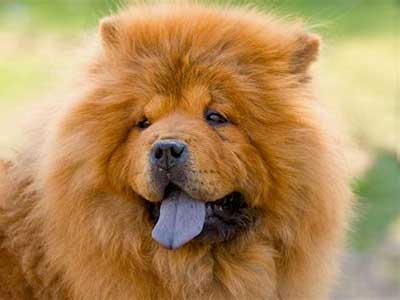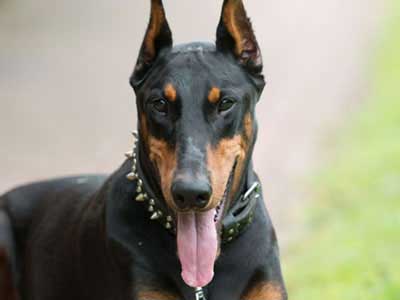Alaskan Malamute
Breed Information |
|
|---|---|
| Popularity |
2022: #67 2021: #68 2020: #65 2019: #64 2018: #58 2017: #59 2016: #59 2015: #54 |
| Name | Alaskan Malamute |
| Other names | Mal, Mally |
| Origin |  United States United States |
| Breed Group |
Working (AKC:1935) Northern Breeds (UKC) |
| Size | Large |
| Type | Purebred |
| Life span | 12-15 years |
| Temperament |
Affectionate Devoted Dignified Friendly Loyal Playful |
| Height |
Male: 24 - 26 inches (61 - 66 cm) Female: 22 - 24 inches (56 - 61 cm) |
| Weight |
Male: 80 - 95 pounds (36 - 43 kg) Female: 70 - 85 pounds (32 - 38 kg) |
| Colors |
Black Gray Red White |
| Litter Size | 4-10 puppies |
| Puppy Prices |
Average $1200 - $2000 USD Usually, the average price of an Alaskan Malamute puppy from a reputable breeder is between $1,200 and $2,000, while a top-quality Alaskan Malamute puppy can cost as high as $3,000. Their price depends upon the pup’s age, sex, quality, pedigree, and breeder’s location. |
Breed Characteristics |
|
|---|---|
| Adaptability |
3 stars |
| Apartment Friendly |
1 stars Alaskan Malamutes are not recommended for apartment life. They are fairly active indoors and should have at least a large yard. If you live in a suburban area, a high fence is a must, but bury the base, because they are likely to dig their way out. The Alaskan Malamute likes to roam in what he considers to be his territory. The Malamutes coat allows them to withstand extreme cold, but be careful to keep the dogs cool in hot climates. Make sure they have shade and plenty of clean cool water. |
| Barking Tendencies |
4 stars Frequent |
| Cat Friendly |
1 stars |
| Child Friendly |
4 stars Good with Kids: This is a suitable breed for kids and is known to be playful, energetic, and affectionate around them. |
| Dog Friendly |
1 stars |
| Exercise Needs |
4 stars Malamutes need a reasonable amount of exercise which include long daily walks. But be careful not to overdo it in warm weather. |
| Grooming |
3 stars Moderate Maintenance: Adapted for harsh, Arctic life, the Malamute's beautiful waterproof double coat requires regular brushing and bathing to stay healthy. They have thick coats, which shed heavily twice a year. Using a pin brush and a metal-toothed ‘greyhound’ comb for brushing will help keep his coat in good condition and keep seasonal shedding more manageable. Be sure to brush him daily and check for mats which can hide fungus and hot spots which may become infected. Thick nails require regular trimming with a nail clipper or grinder. Check ears weekly for accumulated dirt, wax or other foreign matter that may result in an infection. Teeth should be brushed regularly. |
| Health Issues |
3 stars Hypoallergenic: No |
| Intelligence |
4 stars Ranking: #50 Full Ranking List |
| Playfulness |
4 stars |
| Shedding Level |
5 stars Constant and Seasonal Shedding: Expect this dog to shed frequently. Be prepared to vacuum often. Brushing will reduce shedding as well as make the coat softer and cleaner. |
| Stranger Friendly |
4 stars |
| Trainability |
4 stars Moderately Easy Training: Although they are friendly and well mannered, Alaskan Malamutes need a firm approach in their training to achieve obedience. Some Alaskan Malamutes may be difficult to housebreak. |
| Watchdog Ability |
5 stars |
Alaskan Malamute Names |
||
|---|---|---|
| Rank | Boy Names | Girl Names |
| 01 | Charlie | Lucy |
| 02 | Max | Bella |
| 03 | Rocky | Bailey |
| 04 | Jake | Molly |
| 05 | Riley | Lola |
| 06 | Duke | Stella |
| 07 | Sam | Roxy |
| 08 | Toby | Luna |
| 09 | Milo | Layla |
| 10 | Dexter | Zoe |
| 100 Cute Puppy Names › | ||
Overview |
|---|
|
The Alaskan malamute is a powerfully built dog of Nordic breed type, developed to haul heavy loads rather than race. It is slightly longer than it is tall. It is heavy-boned and compact, designed for strength and endurance. Its gait is steady, balanced and tireless. Its coat is thick and double, with a coarse outer coat and dense, wooly, oily undercoat, providing the ultimate in insulation. Although its eyes have a "wolf-like" appearance, its expression is soft. The Alaskan malamute is powerful, independent, strong-willed and fun-loving. Its idea of great fun is to pull a sled or cart, but it also loves to run and roam. It is family-oriented, and as long as it is given daily exercise, it is well-mannered in the home. Without proper exercise, it can become frustrated and destructive. It is friendly and sociable toward people, but it may be aggressive toward strange dogs, pets or livestock. Some can be domineering. It tends to dig and howl. |
History |
|
The Alaskan Malamute is a Nordic sled dog descended from the Arctic wolf. Its name comes from Mahlemuts, an Alaskan tribe that raised and cared for these beautiful snow dogs. Originally used 2000 to 3000 years ago by these Mahlemuit Eskimos of Alaska, these highly valued dogs were their only form of transportation. These amazing dogs have strength and endurance with a will to work. They pulled not only light traveling sleds, but they also hauled heavy loads of food and supplies for the Arctic people. Packs of Malamutes have participated in many polar expeditions, for which they are particularly well adapted due to their tenacity, sense of direction, and excellent sense of smell. They have appeared as unforgettable characters in the stories of Jack London and Rudyard Kipling. The Malamute went with Admiral Byrd's expeditions to the South Pole. The Alaskan Malamute is cousins with the Arctic breeds Siberian Husky, Samoyed, and the American Eskimo dog. Some of the Alaskan Malamute's talents are sledding, carting, search and rescue, weight pulling and racing. |
References
- [1] ^ YouTube: Alaskan Malamute - Top 10 Facts
- [2] ^ YouTube: Alaskan Malamute vs Siberian Husky Which is Better?
